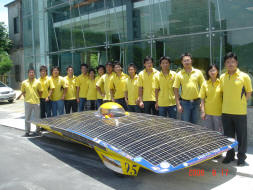 |
|
ˇ@ |
| ˇ@ |
|
|
|
ˇ@ | ||||||||||||||||||
| ˇ@ The Apollo Solar Car Team |
|||||||||||||||||||||
|
Presently, KUAS has an enrollment of over ten thousand full-time students and a faculty of more than three hundred full-time lecturers. The various departments contain many eminent and highly qualified members, in addition to advanced laboratory facilities for optimum learning efficacy. KUAS comprises of two campuses: Chien-kung campus is situated in downtown Kaohsiung; it is a lush vibrant academic oasis, amidst the hustle and bustle of a high quality functional metropolitan environment, offering serenity and repose from the warm subtropical climate of southern Taiwan. The Yenchao campus sits on an area of 110 hectares, in the greater Kaohsiung area and has reserved considerable space for the Universityˇ¦s expansion. KUAS has four academic institutes, the College of Engineering, the College of Electric and Information, the College of Management, and the College of Humanities and Social Sciences; together with a division for promotion of continuing education. Our predecessors have built up a reputable record at National Kaohsiung University of Applied Sciences; praised for its educational excellence and its extensive collaboration with both local and national industries. Rising to meet the learning wave in the era of globalization, the school has been building academic alliances across Asia, America, and Europe; presently connected with more than twenty prestigious universities. The KUAS ethos of entrenchment in Taiwan coupled with a cosmopolitan outlook focused on creating a world-wide network has proved tremendously efficacious creating international competitiveness for both the school and its students. The Introduction of the Apollo Solar Car Team The Apollo Solar Car Team was founded in 1998. It was the first solar car team in Taiwan. Professor Herchang Ay has been in charge of the team since 1998. Most of the team members are engineering students. The funds to develop the solar cars mainly came from the National Science Council and the Ministry of Education. The Apollo solar car team has so far developed 5 vehicles. At the end of 2002, our team used Apollo III, our third generation solar car, to complete a 700-kilometer round trip route between Tainan and Taipei. This is first record for a solar car in Taiwan. Residents of Taiwan followed the solar car event with great interest as it representsed the countryˇ¦s successful pioneering work. In 2003, the Apollo team entered the World Solar Challenge (WSC); the first time Taiwan was represented in the WSC. Even though it was the teamˇ¦s first time entering the event, they were able to obtain 7th place; the best grade among Asian teams. The Apollo team holds the record for the trans-Australia crossing in a time of 43 hours and 41 minutes traveling more than 3,000 km from Darwin to Adelaide. In 2004, Professor Ay led the team again to enter the Phaethon 2004 Solar Rally, which is an initiative of the ²Cultural Olympiad². The event saw 22 teams from 9 countries in the race. Apollo was the only Taiwanese team. Although the Apollo IV solar car flipped over before the rally race, they were still able to obtain 4th place. In 2005, the team used the Apollo-PLUS solar car in the Suzuka DreamCup in Japan. This was the first time Taiwan was represented in the DreamCup. At the end of September 2005, the Apollo team entered the WSC again. Even though the team had an accident causing serious damage to the Apollo V solar car on the beginning day, they still managed to obtain 7th place again. Solar vehicles are solely powered by the sunˇ¦s energy. The Apollo V team has made tremendous progress over the past few years with the recently established Southern Solar School by the Ministry of Education. The Apollo V is the lightest, thinnest and most technologically advanced solar car yet. It combines aircraft composite construction with satellite grade solar cells and lithium-polymer batteries, all based on an ultra-light composite space frame chassis. Apollo Vˇ¦s arrays are 25% efficient Gallium Arsenide cells. The arrays peak at 1800 watts of power. For the front suspension, the Apollo solar car uses Double A arms due to required vertical clearance, while a trailing arm used at the rear suspension. Apollo V has regenerative braking where the car's motor becomes a generator and adds energy to the batteries during deceleration. The Apollo V can reach a top speed of 150 km/hr. By pursuing the solar car project, the team hopes to demonstrate the viability and applications of renewable energies in our daily lives. As our worldˇ¦s resources decline, we must look to new and innovative ways to supplement our energy needs. |
|||||||||||||||||||||


